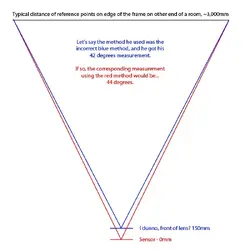Oh my god @everyone in this thread, seriously? He's obviously saying it is not as wide as advertised... not that he doesn't understand crop factors. As in, the lens
is actually a 25mm lens straight up, when the barrel numbers say it's supposed to be 18, or whatever. Which, Mr. OP, in answer to your question, that happens
ALL THE TIME, and is not weird at all, companies constantly lie or fudge their millimeters, or at least mislead.
As suggested by somebody i think, do note that lenses will change their angle of view sometimes based on how near or far you are focusing (this is a phenomenon referred to as "
focus breathing," and most good lens reviews will cover how much focus breathing a given lens has, because it is a factor of critical importance to videographers. Lenses that perfectly maintain ACTUAL focal length for all focal distances at a given written number on the barrel are called "
parfocal" lenses. Generally a good hint that a lens might be parfocal is a constant max aperture, but not a guarantee). So the lens might be accurate at, say, infinity, or some specific distance of focus, but not any other. Which is one way that sketchy manufacturers can get away with advertising one number and having it not actually be that wide most of the time, without legally getting in trouble.
Other times, though, companies just flat out lie or round to the nearest marketable number even if that actual FL isn't achieved at any focal distance, blatantly in disregard of ethics. This is especially prevalent at the telephoto end, where 278mm will often just be called 300mm and they call it a day. I wouldn't be surprised at the wide end either, though, even if somewhat less common.
The angle of a lens does not change merely by placing it on a different camera.
By the way, yes it absolutely does. In fact, not only does it change based on sensor length, but angle of view isn't even
defined without reference to a specific film or sensor size. If I just tell you "300mm" without reference to any specific sensor or film, it is completely impossible to give me any corresponding angle, because you don't have all the parameters you need.
A 300mm lens on a crop sensor is about 5 degrees of visual angle, and a 300mm lens on a large format camera is 29+ degrees of visual angle...





![[No title]](/data/xfmg/thumbnail/37/37623-b930ccd802f79b9c9cea990a7a5e5462.jpg?1734170747)

![[No title]](/data/xfmg/thumbnail/36/36400-97a007ae878e1032155c7a7d47eeba73.jpg?1734168786)


![[No title]](/data/xfmg/thumbnail/30/30995-7e48e5498fe9a56ea3d405cf87f3a1ec.jpg?1734159070)


